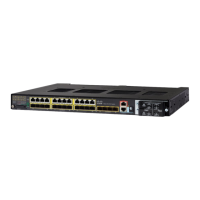654
Configuring Static IP Unicast Routing
How to Configure Static IP Unicast Routing
Types of Routing
Routers and Layer 3 switches can route packets in these ways:
Using default routing to send traffic with a destination unknown to the router to a default outlet or destination
Using static routes to forward packets from predetermined ports through a single path into and out of a network
Dynamically calculating routes by using a routing protocol
The switch supports static routes and default routes. It does not support routing protocols.
How to Configure Static IP Unicast Routing
Steps for Configuring Routing
In these procedures, the specified interface must be a switch virtual interface (SVI)—a VLAN interface created by using
the interface vlan vlan_id global configuration command and by default a Layer 3 interface. All Layer 3 interfaces on
which routing will occur must have IP addresses assigned to them. See Assigning IP Addresses to SVIs, page 654.
Note: The switch supports 16 static routes (including user-configured routes and the default route) and any directly
connected routes and default routes for the management interface. The switch can have an IP address assigned to each
SVI. Before enabling routing, enter the sdm prefer lanbase-routing global configuration command and reload the
switch.
Procedures for configuring routing:
To support VLAN interfaces, create and configure VLANs on the switch, and assign VLAN membership to Layer 2
interfaces.
Configure Layer 3 interfaces (SVIs) and physical routed port (no switchport).
Assign IP addresses to the Layer 3 interfaces.
Configure static routes
Enabling IP Unicast Routing
By default, the switch is in Layer 2 switching mode, and IP routing is disabled. To use the Layer 3 capabilities of the
switch, enable IP routing.
Assigning IP Addresses to SVIs
To configure IP routing, you need to assign IP addresses to Layer 3 network interfaces. This enables communication with
the hosts on those interfaces that use IP. IP routing is disabled by default, and no IP addresses are assigned to SVIs.
Command Purpose
1. configure terminal Enters global configuration mode.
2. ip routing Enables IP routing.
3. end Returns to privileged EXEC mode.

